In the vibrant landscapes of Texas, you can encounter a dazzling array of hummingbirds, a total of 16 distinct species gracing the skies with their iridescent plumage and agile flight.
These enchanting avian wonders, ranging from the iconic Ruby-throated to the captivating Violet-crowned, contribute to the region’s rich biodiversity.
Each species brings its unique colors, behaviors, and ecological significance, creating a tapestry of life that captivates observers and nature enthusiasts alike.
This exploration delves into the intricate world of 16 hummingbird species in Texas, offering insights into their habitats, migratory patterns, and their crucial role in pollination.
Join us on a journey to discover the charm and diversity of these tiny yet remarkable creatures, enhancing our appreciation for the avian marvels that grace the Lone Star State.
16 Hummingbirds in Texas
Embark on a Texan adventure as we unravel the allure of 16 hummingbird species. From the fiery hues of the Rufous to the elegant flights of the Broad-tailed, explore the vibrant tapestry of avian life adorning Texas skies.
1. Ruby-throated Hummingbird
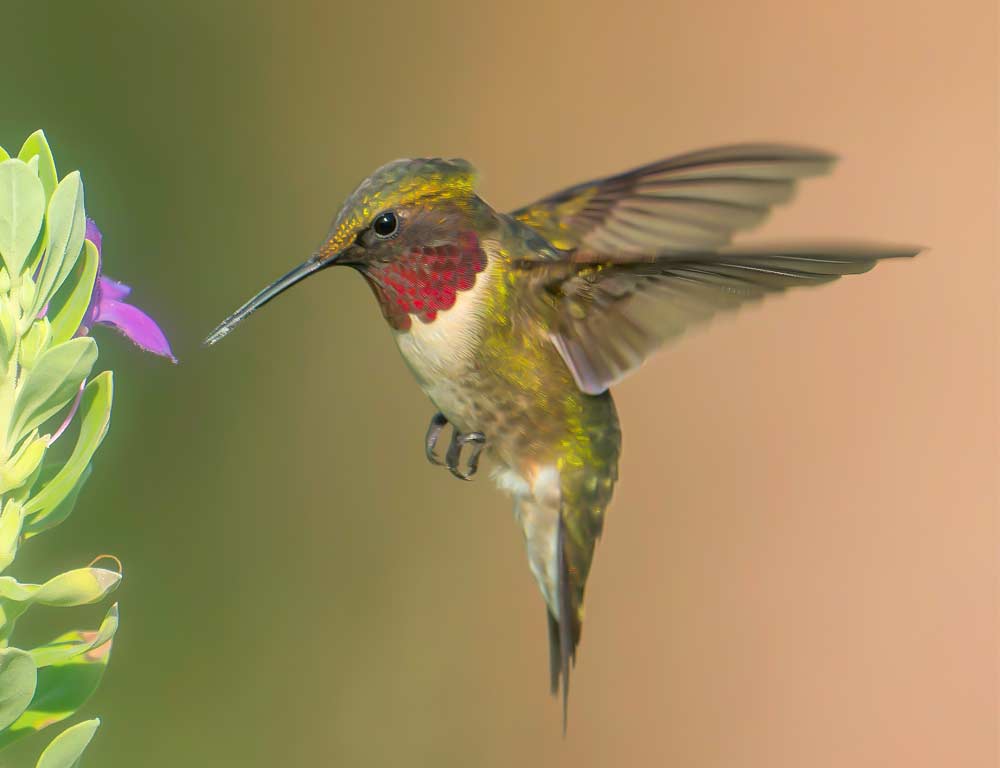
- Scientific name: Archilochus colubris
- Life span: 3 to 5 years
- Size: 3 to 3.5 inches
- Weight: 2 to 20 grams
- Food: Nectar, insects, tree sap
- Wingspan: 3 to 4 inches
- Status: Least Concern
The Ruby-throated Hummingbird is the only hummingbird species that breeds in eastern North America.
These vibrant birds showcase emerald-green plumage with a dazzling ruby-red throat. They have a relatively short life span of 3 to 5 years and are known for their agility and acrobatic flight.
Ruby-throated Hummingbirds primarily feed on nectar from various flowers, supplemented with insects and tree sap for essential proteins.
Their slender build and rapid wing beats, averaging 53 times per second, enable them to hover and navigate with precision.
These birds migrate across the Gulf of Mexico to Central America for the winter, covering approximately 500 miles. During the breeding season, males engage in elaborate aerial displays to attract females.
Despite being the only hummingbird species in eastern North America, their populations are stable, earning them a “Least Concern” status.
2. Black-chinned Hummingbird
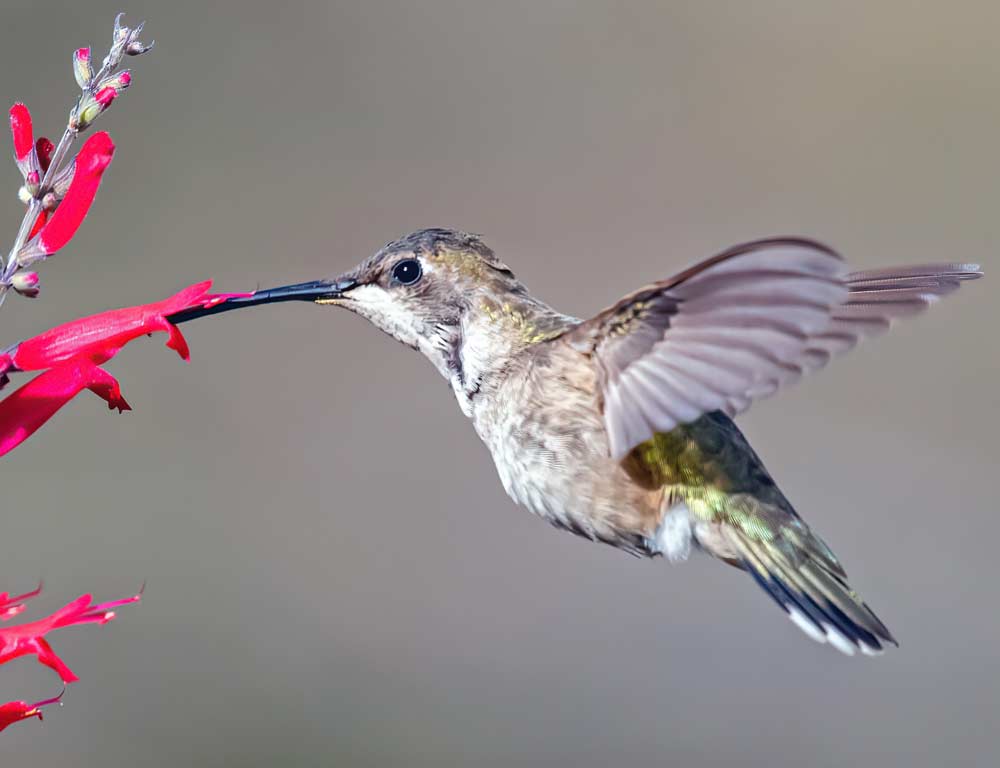
- Scientific name: Archilochus alexandri
- Life span: 3 to 5 years
- Size: 3.5 to 4 inches
- Weight: 2 to 5 grams
- Food: Nectar, insects
- Wingspan: 4 to 4.5 inches
- Status: Least Concern
The Black-chinned Hummingbird is a medium-sized hummingbird with iridescent green plumage and a blackish-purple throat patch, often difficult to discern.
With a life span of 3 to 5 years, these birds inhabit diverse habitats, from mountainous regions to desert scrublands.
Black-chinned Hummingbirds primarily feed on nectar from various flowers, occasionally supplementing their diet with insects. Their wingspan, spanning 4 to 4.5 inches, aids their agile flight and hovering capabilities.
These hummingbirds undertake impressive migrations, traveling between their breeding grounds in western North America and wintering grounds in Mexico.
During the breeding season, males display aerial acrobatics and vocalizations to attract mates. Despite facing habitat loss and climate change threats, their populations remain stable, earning them a “Least Concern” status.
3. Rufous Hummingbird
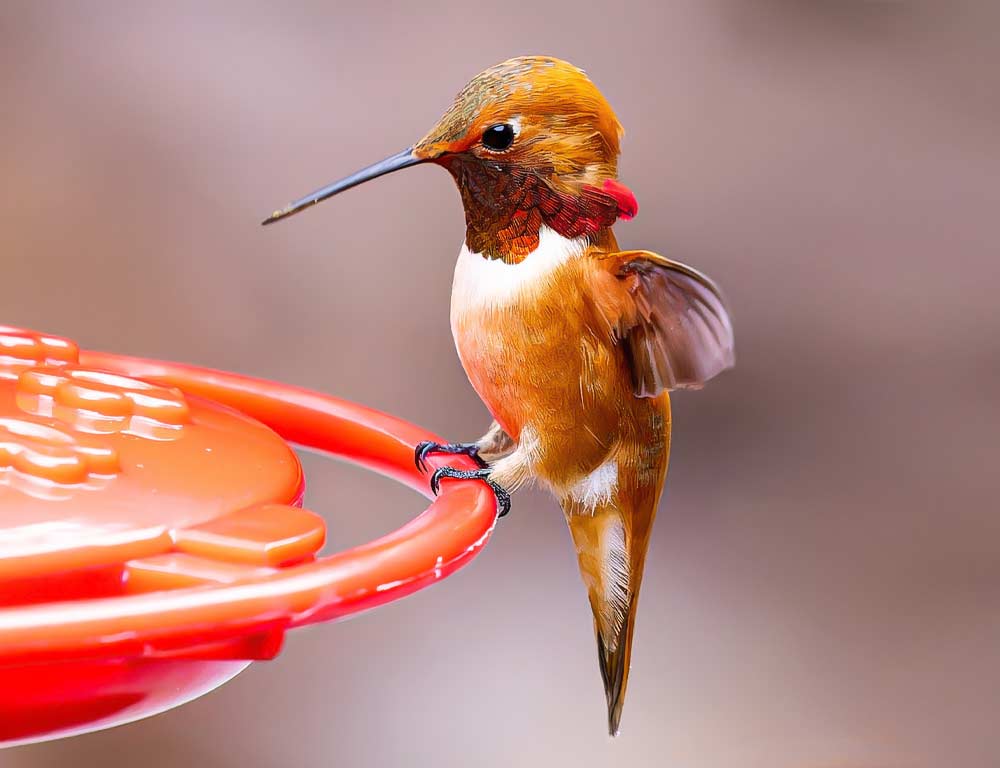
- Scientific name: Selasphorus rufus
- Life span: 3 to 5 years
- Size: 3.5 to 4 inches
- Weight: 2 to 5 grams
- Food: Nectar, insects
- Wingspan: 4 to 4.5 inches
- Status: Least Concern
The Rufous Hummingbird is a charismatic species known for its fiery orange plumage, especially in males. These birds have a life span of 3 to 5 years and are found across western North America, from Alaska to Mexico.
Rufous Hummingbirds primarily feed on nectar from various flowers, supplementing their diet with insects for protein.
Their compact size, ranging from 3.5 to 4 inches, and agile flight allows them to explore various habitats, from mountainous regions to coastal areas.
These hummingbirds are remarkable migrants, covering immense distances during their annual migration.
They breed in the northern regions and migrate to Mexico for the winter, covering thousands of miles. Males engage in aerial displays during courtship, creating impressive arcs and loops.
While Rufous Hummingbirds face habitat loss and climate change threats, their populations remain stable, earning them a “Least Concern” status. Conservation efforts focus on preserving their diverse habitats across their migratory routes.
4. Calliope Hummingbird
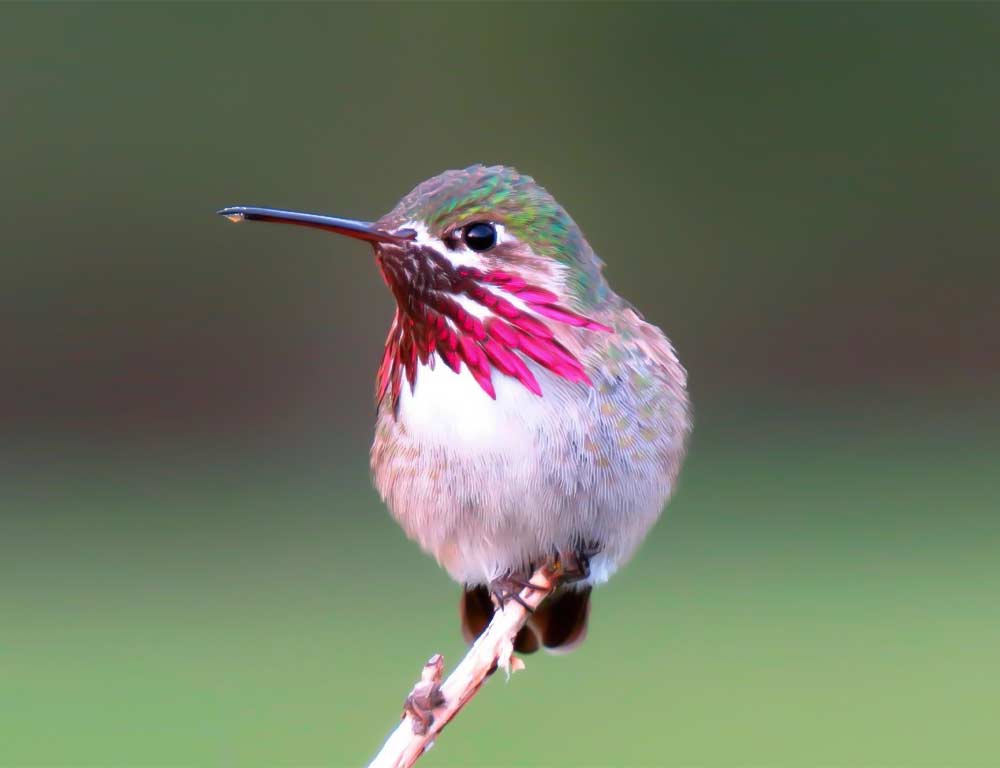
- Scientific name: Selasphorus calliope
- Life span: 3 to 5 years
- Size: 2.8 to 3.5 inches
- Weight: 2 to 4 grams
- Food: Nectar, insects
- Wingspan: 3.5 to 4 inches
- Status: Least Concern
The Calliope Hummingbird, the smallest bird in North America, is distinguished by its vibrant purple throat and green plumage. With a life span of 3 to 5 years, these tiny hummingbirds are found in mountainous regions of western North America.
Feeding primarily on nectar from flowers, Calliope Hummingbirds also supplement their diet with insects. Their diminutive size, ranging from 2.8 to 3.5 inches, and agile flight allow them to navigate through alpine meadows and flower-rich environments.
During the breeding season, males perform elaborate aerial displays, including rapid dives and pendulum-like swings, to attract females.
Despite their small size, Calliope Hummingbirds are remarkable long-distance migrants, wintering in Mexico and Central America. Conservation efforts aim to protect their breeding habitats and migration routes.
5. Broad-tailed Hummingbird
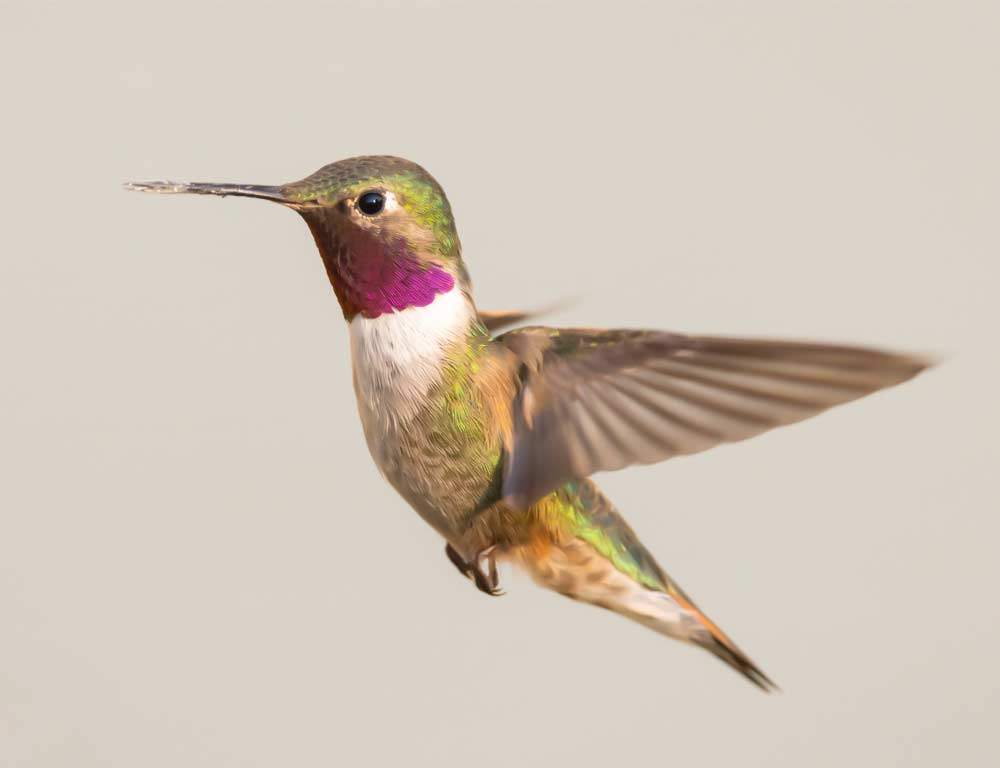
- Scientific name: Selasphorus platycercus
- Life span: 3 to 5 years
- Size: 4 to 4.3 inches
- Weight: 3 to 8 grams
- Food: Nectar, insects
- Wingspan: 4.5 to 5 inches
- Status: Least Concern
The Broad-tailed Hummingbird is recognized by its iridescent green plumage and a distinct trilling sound produced by its wings during flight.
With a life span of 3 to 5 years, these medium-sized hummingbirds inhabit mountainous regions of western North America.
Feeding on nectar and insects, Broad-tailed Hummingbirds are important pollinators for various flowering plants. Their size, ranging from 4 to 4.3 inches, and a wingspan of 4.5 to 5 inches, contribute to their agile and efficient flight.
During breeding, males engage in aerial displays, showcasing their iridescent gorget to attract mates.
These hummingbirds are known for their migratory behavior, traveling between their breeding grounds and wintering areas in Mexico and Central America. Conservation efforts focus on preserving their mountainous habitats and migration routes.
6. Anna’s Hummingbird
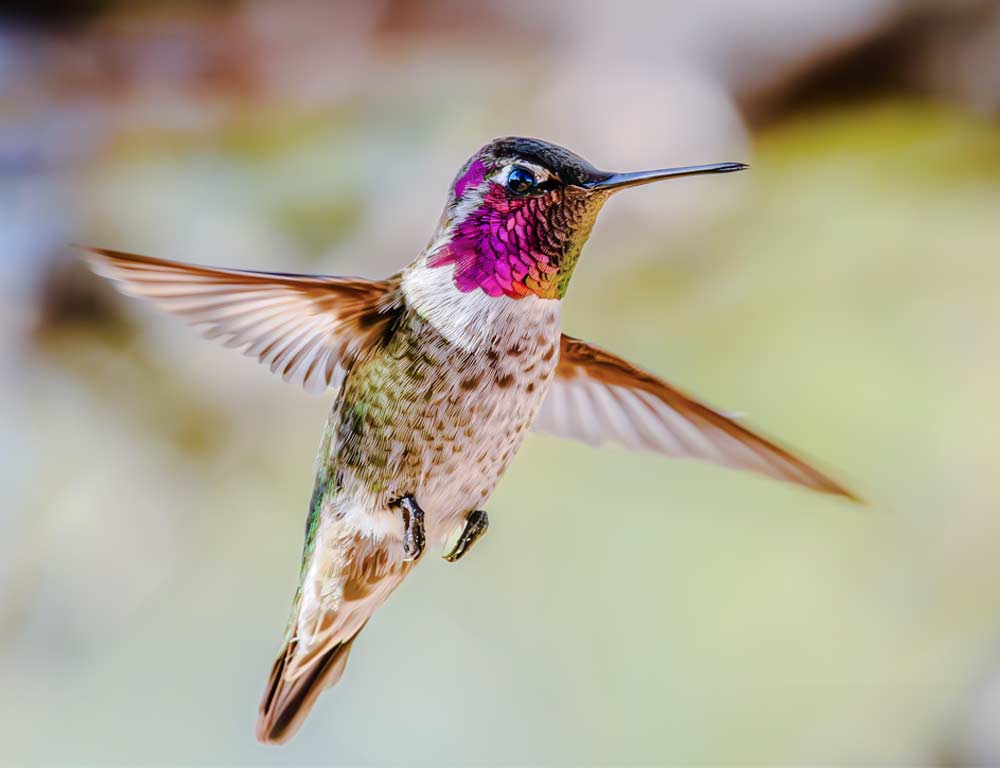
- Scientific name: Calypte anna
- Life span: 3 to 5 years
- Size: 3.5 to 4 inches
- Weight: 3 to 6 grams
- Food: Nectar, insects
- Wingspan: 4 to 4.7 inches
- Status: Least Concern
Anna’s Hummingbird, endemic to the western coastal regions of North America, is known for its striking iridescent pink-red throat and head feathers.
With a life span of 3 to 5 years, these medium-sized hummingbirds are adaptable to urban and suburban environments.
Feeding on nectar from flowers and supplementing with insects, Anna’s Hummingbirds play a vital role in pollination.
Their size, ranging from 3.5 to 4 inches, and a wingspan of 4 to 4.7 inches enable them to navigate through diverse habitats.
Anna’s Hummingbirds do not migrate long distances but may shift their range in response to seasonal changes in food availability.
Conservation efforts focus on providing suitable nesting and feeding habitats, especially in urban areas where they have adapted.
7. Buff-bellied Hummingbird
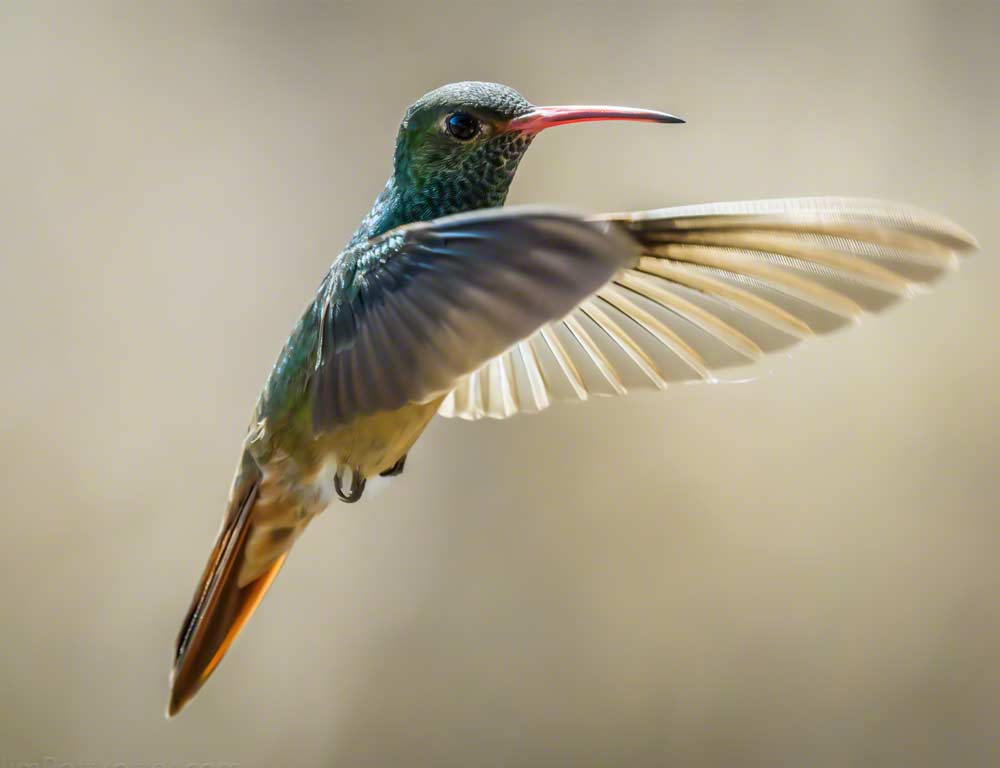
- Scientific name: Amazilia yucatanensis
- Life span: 3 to 5 years
- Size: 3.5 to 4 inches
- Weight: 5 to 10 grams
- Food: Nectar, insects
- Wingspan: 4.5 to 5 inches
- Status: Least Concern
The Buff-bellied Hummingbird, named for its buff-colored belly, is a medium-sized hummingbird found in coastal regions of Texas and Mexico.
With a life span of 3 to 5 years, these birds exhibit a unique combination of green and cinnamon plumage.
Buff-bellied Hummingbirds primarily feed on nectar from various flowers and insects for essential proteins. Their size, ranging from 3.5 to 4 inches, and a wingspan of 4.5 to 5 inches contribute to their agile and versatile flight.
These hummingbirds may exhibit seasonal movements, and some populations may migrate short distances.
Conservation efforts focus on preserving coastal habitats and maintaining diverse flowering plants for their sustenance. Despite facing threats like habitat loss, Buff-bellied Hummingbirds maintain a “Least Concern” status.
8. Rivoli’s Hummingbird
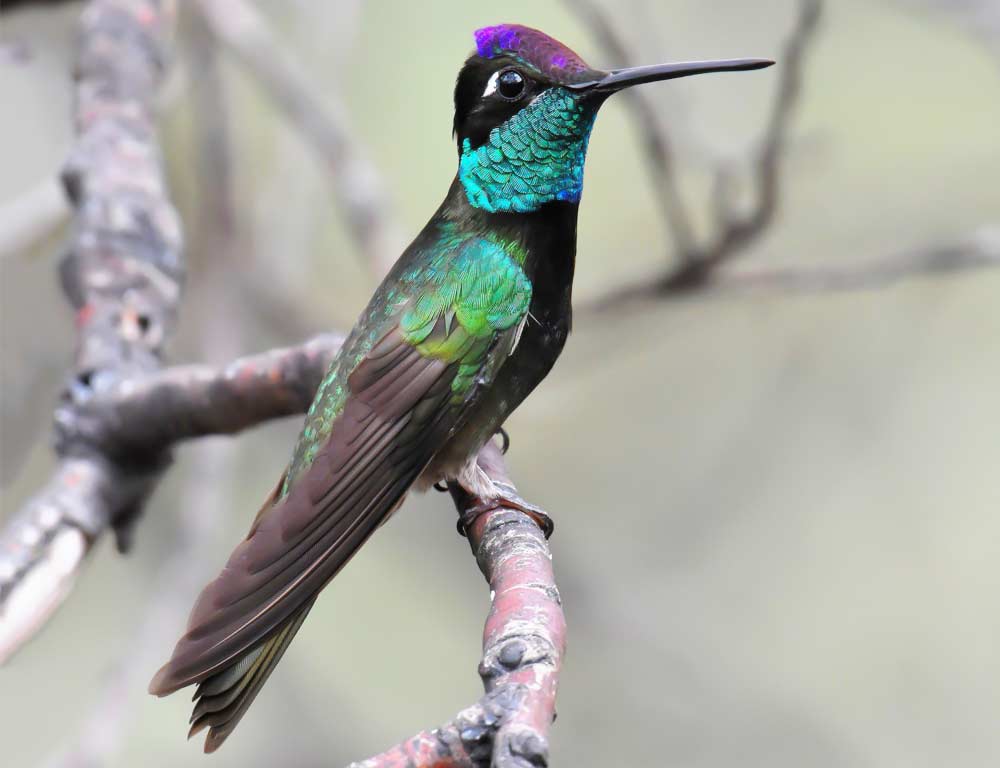
- Scientific name: Eugenes fulgens
- Life span: 5 to 9 years
- Size: 4 to 5 inches
- Weight: 9 to 12 grams
- Food: Nectar, insects
- Wingspan: 5 to 6 inches
- Status: Least Concern
Rivoli’s Hummingbird, also known as the Magnificent Hummingbird, is named after the Duke of Rivoli.
With a life span of 5 to 9 years, these large hummingbirds are found in mountainous regions of western North America, from Mexico to the southwestern United States.
Feeding primarily on nectar from various flowers and supplemented with insects, Rivoli’s Hummingbirds are crucial pollinators for high-altitude plants.
Their size, ranging from 4 to 5 inches, and a wingspan of 5 to 6 inches contribute to their powerful and agile flight. During the breeding season, males display impressive aerial acrobatics to attract females.
Despite their size, Rivoli’s Hummingbirds are remarkable long-distance migrants, traveling between their breeding grounds and wintering areas in Central America.
Conservation efforts focus on preserving their montane habitats and migration routes.
9. Allen’s Hummingbird

- Scientific name: Selasphorus sasin
- Life span: 3 to 5 years
- Size: 3 to 3.5 inches
- Weight: 2 to 4 grams
- Food: Nectar, insects
- Wingspan: 4 to 4.5 inches
- Status: Least Concern
Allen’s Hummingbird, closely related to the Rufous Hummingbird, is distinguished by its orange-red throat and green plumage.
With a life span of 3 to 5 years, these medium-sized hummingbirds are native to the western coastal regions of North America.
Feeding primarily on nectar and insects, Allen’s Hummingbirds play a crucial role in pollination. Their size, ranging from 3 to 3.5 inches, and a wingspan of 4 to 4.5 inches contribute to their agile and precise flight.
During the breeding season, males perform intricate aerial displays, including rapid dives and U-shaped flights, to attract females.
These hummingbirds may exhibit migratory behavior, moving between their breeding grounds and wintering areas. Conservation efforts focus on preserving their coastal habitats and migration routes.
10. Costa’s Hummingbird
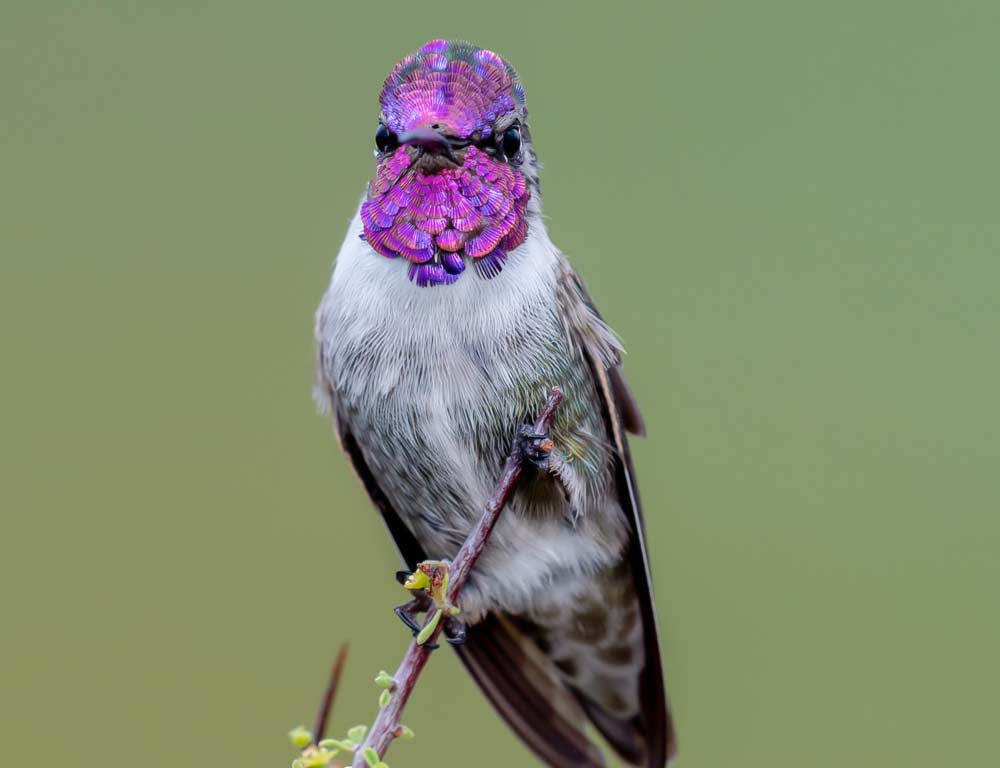
- Scientific name: Calypte costae
- Life span: 3 to 5 years
- Size: 3 to 3.5 inches
- Weight: 2 to 6 grams
- Food: Nectar, insects
- Wingspan: 4 to 4.5 inches
- Status: Least Concern
Costa’s Hummingbird, known for its vibrant violet throat and distinctive buzzing sound during flight, is native to the southwestern United States and Mexico.
With a life span of 3 to 5 years, these small hummingbirds are well-adapted to arid and desert environments.
Feeding on nectar and insects, Costa’s Hummingbirds are important pollinators for desert flora. Their size, ranging from 3 to 3.5 inches, and a wingspan of 4 to 4.5 inches enable them to navigate through arid landscapes with ease.
During breeding, males perform aerial displays, showcasing their violet-colored gorget to attract mates. Costa’s Hummingbirds may exhibit some migratory behavior, moving to lower elevations during the winter.
Conservation efforts focus on preserving their desert habitats and maintaining suitable foraging resources.
11. Lucifer Hummingbird
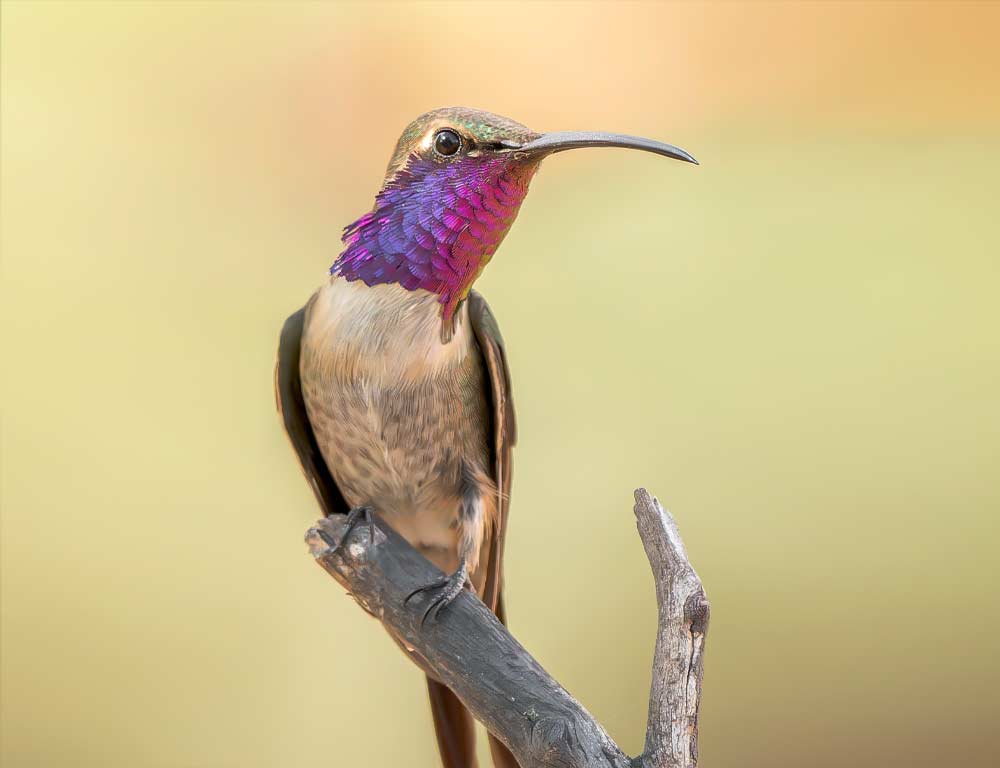
- Scientific name: Calothorax lucifer
- Life span: 3 to 5 years
- Size: 3.5 to 4 inches
- Weight: 3 to 5 grams
- Food: Nectar, insects
- Wingspan: 4 to 4.5 inches
- Status: Least Concern
The Lucifer Hummingbird, named for its vibrant iridescent gorget resembling the morning star, is found in arid and semi-arid regions of the southwestern United States and Mexico.
With a life span of 3 to 5 years, these small hummingbirds are known for their striking colors.
Feeding primarily on nectar and insects, Lucifer Hummingbirds contribute to the pollination of desert flowers. Their size, ranging from 3.5 to 4 inches, and a 4 to 4.5 inches wingspan enable them to navigate through arid landscapes with agility.
During the breeding season, males engage in aerial displays, performing looping flights to attract females. While some populations may exhibit migratory behavior, others may be year-round residents.
Conservation efforts focus on preserving their arid habitats and maintaining diverse flowering plants.
12. Violet-crowned Hummingbird
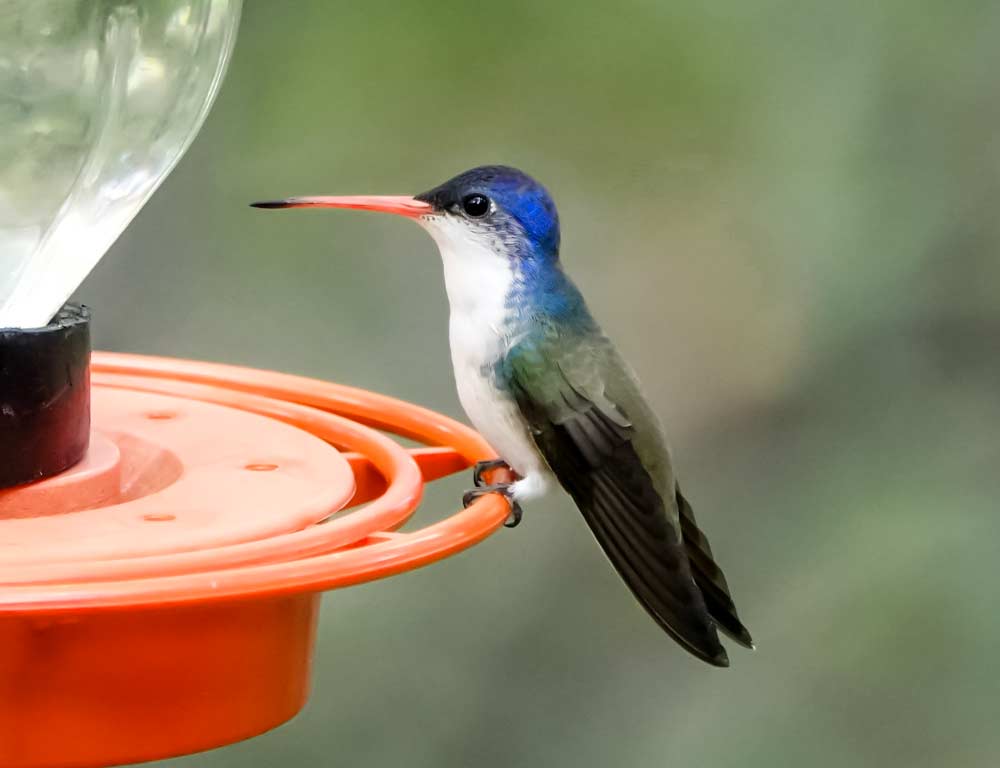
- Scientific name: Amazilia violiceps
- Life span: 3 to 5 years
- Size: 4 to 4.5 inches
- Weight: 6 to 10 grams
- Food: Nectar, insects
- Wingspan: 5 to 6 inches
- Status: Least Concern
The Violet-crowned Hummingbird, known for its vibrant violet crown and greenish upperparts, is found in the southwestern United States and Mexico.
With a life span of 3 to 5 years, these medium-sized hummingbirds inhabit various habitats, including desert scrublands and canyons.
Feeding on nectar and insects, Violet-crowned Hummingbirds are essential pollinators for desert and subtropical plants. Their size, ranging from 4 to 4.5 inches, and a wingspan of 5 to 6 inches contribute to their agile and versatile flight.
These hummingbirds may exhibit some migratory behavior, moving between different elevations in response to seasonal changes.
Conservation efforts focus on preserving their diverse habitats and ensuring the availability of flowering plants for foraging. Despite facing threats like habitat loss, Violet-crowned Hummingbirds maintain a “Least Concern” status.
13. Mexican Violetear Hummingbird
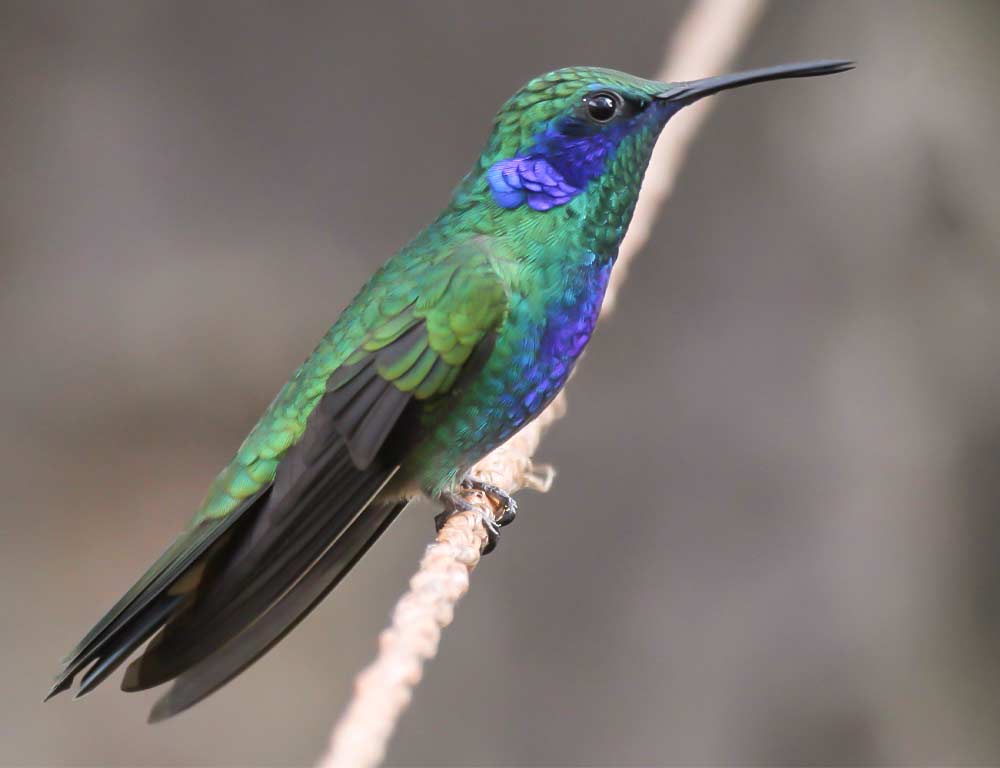
- Scientific name: Colibri thalassinus
- Life span: 5 to 9 years
- Size: 4 to 4.5 inches
- Weight: 7 to 12 grams
- Food: Nectar, insects
- Wingspan: 5 to 6 inches
- Status: Least Concern
The Mexican Violetear Hummingbird is known for its striking violet-blue ear patches and green plumage.
With a life span of 5 to 9 years, these medium-sized hummingbirds inhabit montane forests and cloud forests from Mexico to Central America.
Mexican Violetear Hummingbirds play a vital role in pollination by feeding on nectar from various flowers and supplementing their diet with insects.
Their size, ranging from 4 to 4.5 inches, and a wingspan of 5 to 6 inches contribute to their agile and precise flight. These hummingbirds may exhibit altitudinal migrations, moving to lower elevations during the non-breeding season.
Conservation efforts focus on preserving their montane habitats and ensuring diverse flowering plants for their sustenance.
14. Broad-billed Hummingbird

- Scientific name: Cynanthus latirostris
- Life span: 5 to 7 years
- Size: 3.5 to 4 inches
- Weight: 3 to 6 grams
- Food: Nectar, insects
- Wingspan: 4 to 4.5 inches
- Status: Least Concern
The Broad-billed Hummingbird is recognized for its vibrant plumage, especially the broad, straight bill that sets it apart.
With a life span of 5 to 7 years, these small hummingbirds are found in arid and semi-arid regions of North America, from the southwestern United States to Mexico.
Feeding primarily on nectar from various flowers and supplementing their diet with insects, Broad-billed Hummingbirds are important pollinators for desert flora.
Their size, ranging from 3.5 to 4 inches, and a 4 to 4.5 inches wingspan enable them to navigate through arid landscapes with agility. During the breeding season, males perform aerial displays to attract females, showcasing their colorful plumage.
Conservation efforts focus on preserving their desert habitats and maintaining suitable foraging resources. Despite facing threats like habitat loss, Broad-billed Hummingbirds maintain a “Least Concern” status.
15. White-eared Hummingbird
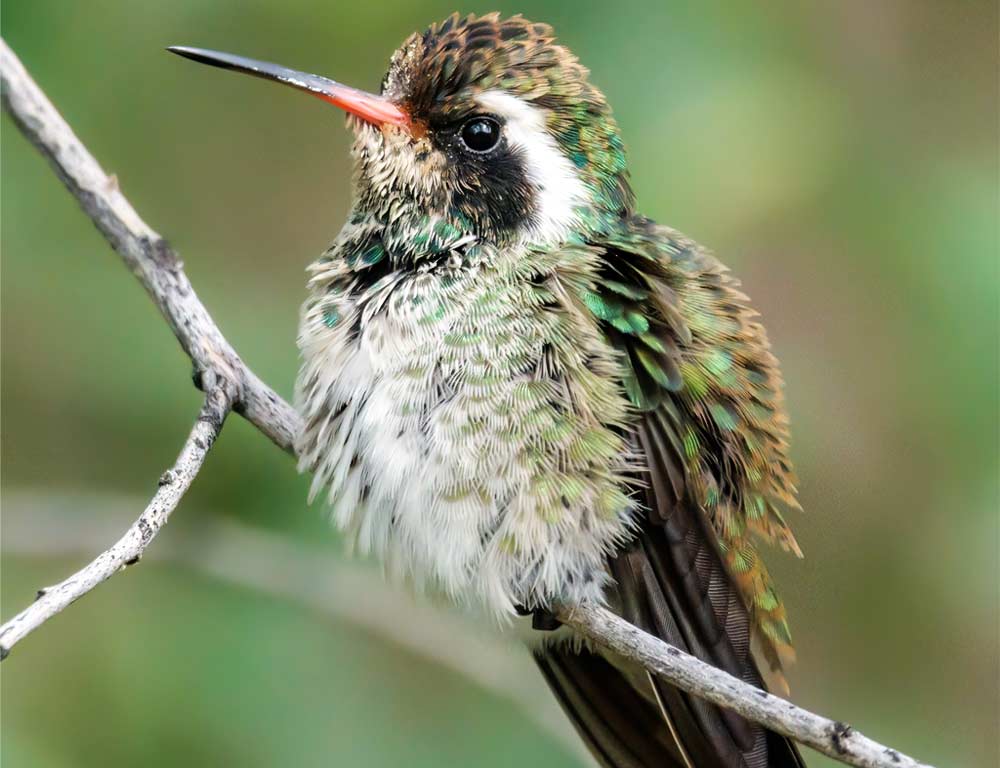
- Scientific name: Hylocharis leucotis
- Life span: 5 to 7 years
- Size: 3.5 to 4 inches
- Weight: 3 to 6 grams
- Food: Nectar, insects
- Wingspan: 4 to 4.5 inches
- Status: Least Concern
The White-eared Hummingbird is characterized by its distinctive white ear patch and iridescent green plumage. With a life span of 5 to 7 years, these small hummingbirds are found in montane regions from Mexico to Central America.
Feeding primarily on nectar from various flowers and supplementing their diet with insects, White-eared Hummingbirds play a vital role in pollination.
Their size, ranging from 3.5 to 4 inches, and a wingspan of 4 to 4.5 inches contribute to their agile and precise flight. During the breeding season, males engage in elaborate aerial displays, showcasing their vibrant plumage to attract females.
These hummingbirds may exhibit altitudinal migrations, moving to lower elevations during the non-breeding season. Conservation efforts focus on preserving their montane habitats and migration routes.
16. Berylline Hummingbird
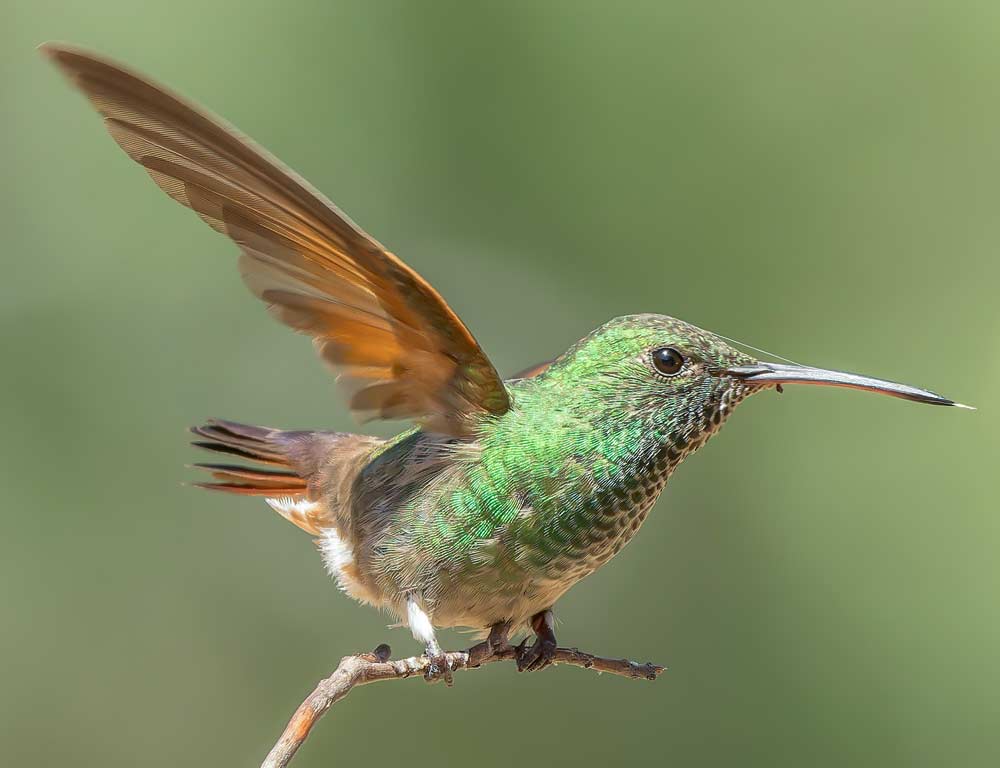
- Scientific name: Amazilia beryllina
- Life span: 5 to 7 years
- Size: 4 to 4.5 inches
- Weight: 4 to 7 grams
- Food: Nectar, insects
- Wingspan: 4.5 to 5 inches
- Status: Least Concern
The Berylline Hummingbird is named for its striking beryl-green plumage. With a life span of 5 to 7 years, these medium-sized hummingbirds are found in mountainous regions from the southwestern United States to Mexico.
Feeding on nectar from various flowers and supplementing their diet with insects, Berylline Hummingbirds contribute to the pollination of high-altitude plants.
Their size, ranging from 4 to 4.5 inches, and a 4.5 to 5 inches wingspan contribute to their agile and versatile flight.
During breeding, males display aerial acrobatics, including rapid dives and U-shaped flights, to attract females. Berylline Hummingbirds may exhibit altitudinal migrations, moving to different elevations during the non-breeding season.
Conservation efforts focus on preserving their montane habitats and ensuring diverse flowering plants for their sustenance.
Wrapping Up
In the diverse landscapes of Texas, hummingbirds enchant with their vibrant hues and agile flight.
From the iconic Ruby-throated to the elusive Rivoli’s, these avian gems contribute to the ecological tapestry, ensuring pollination and floral diversity.
Each species boasts unique traits, from the iridescent elegance of the White-eared to the desert-adapted resilience of the Broad-billed.
Understanding their behaviors, migratory patterns, and conservation needs enhances our appreciation for these tiny yet essential creatures.
As stewards of the environment, preserving their habitats becomes paramount to sustaining the delicate balance of Texas’ ecosystems.
Observing the aerial ballet and intricacies of these hummingbirds enriches our connection with nature, inviting us to marvel at the wonders of the avian world.